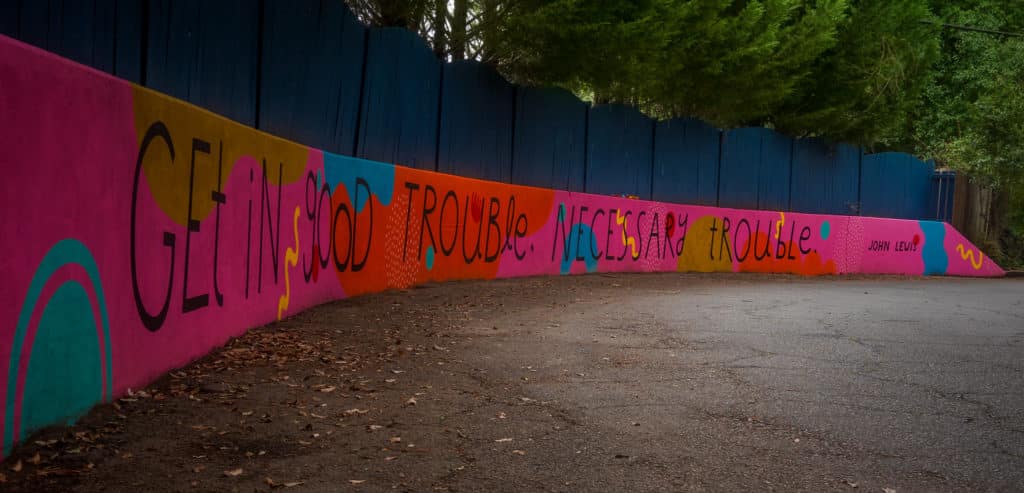
“Get in good trouble” by Thomas Cizauskas is licensed under CC BY-NC-ND 2.0
Imagine Good Trouble, Not Bad
Mimi Jones, born Mamie Ford, was the thirteenth of fourteen children born to her parents in rural Georgia in 1947. She worked on the family farm until her mother took a job in a nearby town. She and her sister moved to town with their mother. There she was influenced by her family’s minister to embrace the Civil Rights Movement and the concept of nonviolent resistance.
Mimi may be best remembered for an event that occurred while the Civil Rights Act of 1964 was stalled in the US Senate. At the age of 17, Mimi responded to the call of the Southern Christian Leadership Conference to take part in a “swim-in” demonstration as part of the ongoing “St. Augustine Movement.” Mimi and six other civil rights activists leaped into a Whites-only motel pool in St. Augustine, Florida. The motel manager responded by pouring acid into the water. A police officer jumped in to arrest the protestors. Mimi, her fellow swimmers, and 40 other protestors, including 16 rabbis who had joined an effort to integrate the motel’s Whites-only restaurant, were taken to jail.
The photo seen here of the manager pouring acid into the pool was on the cover page of the Washington Post and New York Times. The publicity sparked an uproar, gaining national and international attention and catalyzing the Senate’s passage of the stalled Civil Rights Act within 24 hours.
Representative John Lewis is famous for his call to citizens to “get in good trouble, necessary trouble.” Mimi Jones certainly was a role model for getting into good trouble. Some of her good trouble was teaching Black citizens to read so they could pass literacy tests and vote. She was arrested often. She was threatened often. Bombs were tossed into the windows of a meeting where she and others were planning to get into good trouble. Mimi, who passed away this past summer, once remarked, “I’m often asked, ‘How could you have so much courage?’ Courage for me is not the absence of fear, but what you do in the face of fear.”
What separates good trouble from actions such as the storming of the U.S. Capitol on January 6, 2021?
Good trouble is non-violent and focused on correcting inequalities and creating a better society for all, especially in consideration of those who have been marginalized. Good trouble focuses on opening up opportunity for everyone rather than preserving barriers to a good life for some. Good trouble is spurred by hope for an inclusive future where all are free to participate fully in our society—rather than by fear of challenges to the status quo. Good trouble is about expanding and revitalizing our democracy, not undermining it.
Just imagine where our society would be without good trouble. Just imagine how all of us can get into good trouble to make us a more just and equal society. Just imagine how simple acts of good trouble can become catalysts for positive change. How might we envision good trouble in our own time?
* * *
“Do not get lost in a sea of despair. Be hopeful, be optimistic. Our struggle is not the struggle of a day, a week, a month, or a year; it is the struggle of a lifetime. Never, ever be afraid to make some noise and get in good trouble, necessary trouble.” – John Lewis
This is part of our “Just Imagine” series of occasional posts, inviting you to imagine with us positive possibilities for a citizen-centered democracy.